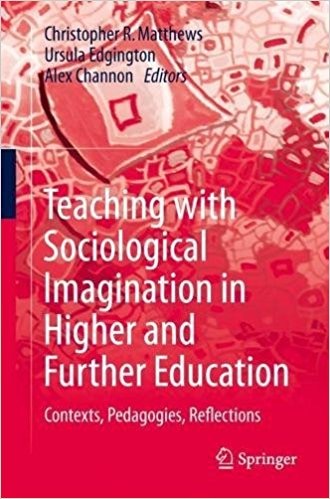imagination
Select an item by clicking its checkbox

Teaching with Sociological Imagination in Higher and Further Education
Date Reviewed: November 29, 2018
With a laudable personal openness and deep dedication to both their field of sociology and the practice of teaching, editors Christopher R. Matthews, Ursula Edgington, and Alex Channon premise their volume Teaching with Sociological Imagination in Higher and Further Education on the idea that the skills of reflexivity and critical thinking are not only skills they stress in their courses to train and develop students, but also skills that can and should inform their own teaching practice. This reflective nature is the guiding purpose of their essay collection, and the contributors therein address that same principle from a variety of angles.
Such a reflexive approach, the editors write in their own section of the volume, “Introduction: Teaching in Turbulent Times,” is emphasized as “an exploration of the importance of teaching with sociological imagination, derived from a critical, reflexive engagement with our own situated practices, theorizations, and professional identities” (xvii). This openness regarding the positionality of the researcher and of the teacher is in large part what sets this volume apart. Briscoe (2005, Educational Studies 38, 23-41) noted that ideological positioning grants that while ideologies derive from one’s experiences and are influenced by one’s demographic positionality, the researcher (and in this case, the teacher) can have experiences that allow him or her to develop empathy with the other (33). The fact that Matthews, Edgington, and Channon foreground this idea sets the tone for the rest if the volume.
For instance, James Arkwright’s essay focuses on education equality as seen through the lens of inclusion and accessibility. The case studies Arkwright includes illustrate the issues and themes of students confronted with short- and long-term illnesses, as well as disabilities, and their experiences in institutions of higher or further education. These cases are built upon by his own story of being an educator who uses a wheelchair, through which he even more strongly makes his case for why the current state of inclusivity may seem positive, while the reality of those inclusive policies in practice could be improved to achieve a greater degree of equity.
Another demonstration of the efficacy of the volume’s premise is Pam Lowe’s entry on the role emotions may play in the learning experience. This topic is timely, as debates on trigger warnings and how or whether to address sensitive issues in class is ongoing. Lowe explores the complexity of educators’ attempts at balancing emotional and sensitive issues with academic objectivity.
Teaching with Sociological Imagination in Higher and Further Education is a valuable collection of topics from a variety of professional angles, all focused on how educators teach reflexivity and critical thinking, while practicing those same principles as educators. In doing so, Matthews, Edgington, and Channon have provided a strong and diverse contribution to the fields of sociology and education, as well as a demonstration of the value inherent in exploring, understanding, and practicing how these fields are interlinked.

Teaching and Christian Imagination
Date Reviewed: November 30, -0001
David I. Smith and Susan M. Felch remind their readers that they are offering “not a ‘how-to’ manual or collection of tips” but “lenses . . . opening possibilities” for effective “learning and teaching” (2). Teaching is not a transaction to dispense knowledge but a multivalent art that should not be reduced to gimmicks. As Smith and Felch conceive of it, teaching is a living process shaped by the imagination of both teacher and student – an experience directed by “visions, not just beliefs and techniques” (1). It is an organic life shaped by theological journeying, farming, and building metaphors. To bolster their argument, Smith and Felch carry their readers through a three-dimensional rubric that reimagines teaching as a biblical hermeneutic – a teaching life that undulates between “journeys and pilgrimages,” “gardens and wildernesses,” and “buildings and walls.” Reading this book as a teacher, I was drawn into the teaching world the authors invite all instructors to enter – it is a world where one hears, sees, thinks, and reimagines inexhaustible possibilities of shaping minds.
The authors draw examples from biblical characters and Christian leaders to illustrate the multifaceted and meandrous journey each of their teaching metaphors conveys. First as pilgrim, the teacher is advised to rely on God, the divine GPS, for the journey (84) – an act that includes rest but does not preclude imagination on the part of the pilgrim. Second, insights and actionable ideas are not caught in vacuum. They are caught in surprising places like gardens, deserts, and classrooms where both teacher and students, like the first humans and liberated communities (Gen 1-3; Exod 1:1-15:27), learned to rethink, develop new perceptions, and take new steps as they journeyed with God. Third, edifices and walls speak about the role and construction of space. Though both building and walls may have a positive role as a course syllabus might (168), one is reminded that spaces delineated by the twin metaphor, buildings and walls, are often vigorously contested in the Bible, as is evidenced in the Household Codes (Eph 5:11-6:11; Col 3:18-4:1; 1 Peter 2:13-3:33) – a reality that did much to reduce many women to a subservient status and silence in the church to this day.
As a Senegalese transnational biblical scholar shaped by African, Islamic, and Christian faith traditions, I find the journeying, farming, and building metaphors that Smith and Felch apply to teaching in not just Christian, but in every faith tradition. In spite of my reservations about limiting such powerful metaphors to only the Christian imagination, this book makes an invaluable contribution for educators. I agree with Smith and Felch, that Teaching and Christian Imagination is indeed an invitation to focus on what kind of person (and therefore what kind of teacher) we are gradually becoming and the place our vision of the world plays in the process . . . to wonder what teaching and learning might look like by those who know that they live in a world created by God who has filled it with beauty and story and song and who talks with us through the vale of tears and draws us toward future glory. (206)
Put differently, Christian educators, and I would add all instructors of any discipline, are invited to take seriously their function as learners and teachers whose growth is inextricably bound to the growth of those they teach. In spite of my minor objection, this book should be in the library or office of any serious teacher, educator, or leader committed to the future of humanity.

Engaging Imagination: Helping Students Become Creative and Reflective Thinkers
Date Reviewed: March 26, 2015
Engaging Imagination: Helping Students Become Creative and Reflective Thinkers poses a challenge to educators across fields to reach beyond traditional teaching and learning methods. Authors Alison James and Stephen D. Brookfield ask, “Why are we not open to varied expressive modes – video, art, drama, poetry, music – to gauge students’ learning? If there are multiple intelligences (Gardner, Frames of Mind: The Theory of Multiple Intelligences [New York, NY: Basic Books, 2011]), if students’ diverse histories, cultural backgrounds, racial identities, and personalities mean teaching and learning is inevitably complex (Allen, Sheve, and Nieter, Understanding Learning Styles: Making a Difference for Diverse Learners [Huntington Beach, CA: Shell Education 2010]) then shouldn’t our approaches to helping and assessing learning exhibit a similar variety” (4)? The book invites us to imagine “what if” (xii) students were given opportunities to explore their learning beyond lectures, discussions, reading, and writing. The authors do not intend to solve the institutional or assessment challenges of teaching more creatively, but to pose ideas for reflection and exploration. Each chapter provides websites to further engage concepts and activities described in the book.
Part I, “Understanding the Role of Imagination in Learning,” argues in three chapters that students learn more effectively when they are given freedom to reflect. This is an engaged reflection, involving: creativity – where students are given ways to “unravel . . . question . . . ponder . . . clarify . . . demonstrate” (57); imagination – which focuses on possibilities; and play – learning engaged from new angles, leading to spontaneous insights.
Part II, “Engaging Imagination Tools and Techniques,” forms the heart of the book and may prove to be a valuable resource to liven up syllabi and classrooms. In each of six chapters, a different way of teaching and learning is presented; two to eight activities are also described in detail, providing practical illustrations. Just one activity from each way of teaching and learning is included here. (1) Visual learning: Students create collages in response to a discussion question. (2) Story and metaphor: Students symbolize key learning experiences on a timeline. (3) Kinesthetic learning: Students use Legos or other concrete objects to construct models of their thinking-in-process. (4) Attending to physical space: A special space in the classroom (or an inflatable “pod”) can serve as a place where students, alone or in small groups, can video their live reflections. (5) Asking non-leading questions: Students are guided to think more deeply about their own beliefs by questions that ask for analogies, opposites, or ways of recognizing certain qualities. (6) Community impact on learning: Students map the various communities in their spheres of life to observe how each shapes their perspectives.
Part III, “Negotiating the Realities of Engaging Imagination,” provides activities for students to navigate energy levels and emotions while learning. In a final chapter authors share how their own imaginations were engaged through the writing process.
Engaging Imagination is not aimed so much at educators helping students to think creatively and reflectively about course content, but rather at presenting ways educators may help students to reflect on themselves as learners. Thus the subtitle can be misleading. However, most of the learning activities could be adapted for deepening student understanding of course content. The emphasis on student self-awareness contributes to the current pedagogical shift from teaching to impart information towards facilitating and empowering student-directed learning in a variety of classroom and online settings. Little is offered by way of guiding students towards a directed end; indeed doing so would negate the purpose of many of the activities. It is therefore significant that authors acknowledge their work as a complement to, rather than replacement of, traditional forms of teaching and learning. We are left with the same challenge students will have as a result of “engaging imagination”: to appropriate the insights gained.
In the final seconds of their struggle, Ferguson, Missouri police officer Darren Wilson shot and killed Michael Brown because of a visual impression. From Wilson's point of view, Brown appeared to him like Hulk Hogan, and like a demon. His only conceivable response, he stated, was to shoot. Six bullets ...
I have been a lifelong doodler. In fact, my college class notes look more like sketchbooks than notebooks (and the doodles are the only reason I’ve kept some of my college notes). Even today pencil and sketchpad are not far from reach in the event an idle moment provides ...

